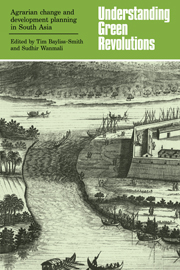Book contents
- Frontmatter
- Contents
- List of contributors
- Preface
- I Understanding Green Revolutions: an overview
- 1 The agricultural revolution in Western Europe
- 2 Land reform as a pre-condition for Green Revolution in Latin America
- 3 Frogs and farmers: the Green Revolution in India, and its murky past
- 4 Agrarian change and the Merchant State in Tamil Nadu
- II Agrarian change at village level
- III Development planning and agrarian change
- Index
1 - The agricultural revolution in Western Europe
Published online by Cambridge University Press: 25 May 2010
- Frontmatter
- Contents
- List of contributors
- Preface
- I Understanding Green Revolutions: an overview
- 1 The agricultural revolution in Western Europe
- 2 Land reform as a pre-condition for Green Revolution in Latin America
- 3 Frogs and farmers: the Green Revolution in India, and its murky past
- 4 Agrarian change and the Merchant State in Tamil Nadu
- II Agrarian change at village level
- III Development planning and agrarian change
- Index
Summary
Much of the literature that has described the agriculture of the less developed countries has emphasised the backwardness of their farming methods. But it is worth noting that both their food and total agricultural output has increased rapidly since 1950; indeed it has not only increased as rapidly as output in the developed countries in this period, but more rapidly than in Europe at any time before 1950. In Europe agricultural output has also grown at a high rate since 1950, and many have described this as an agricultural revolution. The achievements of Afro-Asia and Latin America, in contrast, have been damned with faint praise. The first reason for this is that population has grown nearly as rapidly as food output in this period so that there have not been dramatic improvements in per caput food supplies, although a smaller proportion of the population have inadequate diets than in 1950 (Grigg, 1981, 1982a). A second reason is that the Green Revolution, which many regard as the principal cause of increased output, is alleged to have also caused landlessness and increasing income inequality in rural Asia. A third reason for confusion is the lack of any agreed methodology for measuring the nature and pace of agricultural change in these regions. This problem is not new. The agricultural revolution in Western Europe has also been the subject of much controversy. The aim of this chapter is to show why the past has been so variously interpreted.
- Type
- Chapter
- Information
- Understanding Green RevolutionsAgrarian Change and Development Planning in South Asia, pp. 1 - 17Publisher: Cambridge University PressPrint publication year: 1984
- 2
- Cited by



